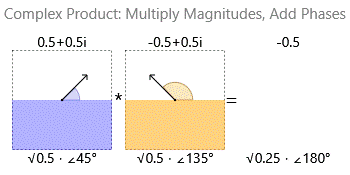What does it mean to divide a complex number by another complex number?
Complex numbers' multiplication is better understood if you forget the "cartesian vector in the complex plane" analogy: $$ z = a + b i \quad z \in \mathbb{C}, a, b \in \mathbb{R} $$ And in stead think in polar coordinates: $$z = r \angle \theta = r e^{i \theta} \quad z \in \mathbb{C}, r \in \mathbb{R}^+, \theta \in [0, 2 \pi) $$ Wherein $r$ is the magnitude, $\theta$ is the angle.
When multiplying it is easy: $$ z w = (r_z r_w) \angle (\theta _z + \theta _w) $$ You add the angles and multiply the magnitudes.
When dividing you do what comes naturally: $$ \frac z w = \left(\! \frac{r_z}{r_w} \!\right) \angle (\theta _z - \theta _w) $$ To divide means to find the difference in angles and the factor in magnitude.
It means to find another complex number $y$, such that $xy=w$. (Just as it does for real numbers.)
When you divide $a$ by $b$, you're asking "What do I multiply $b$ by in order to get $a$?".
Multiplying two complex numbers multiplies their magnitudes and adds their phases:

So when you divide a complex $a$ by a complex $b$ you are asking: "How much do I need to scale $b$ and rotate $b$ in order to get $a$? Please give me a complex number with a magnitude equivalent to how much I must scale and a phase equivalent to how much I must rotate.".
Example
Consider $\frac{1 + i}{1 - i}$. How much do we need to scale and rotate $1-i$ in order to make it the same as $1+i$?
Well, when graphed on the complex plane you can see that $1-i$ has a 45 degree clockwise rotation and a magnitude of $\sqrt{2}$. $1+i$, on the other hand, has a 45 degree counter-clockwise rotation and the same magnitude of $\sqrt{2}$.
Since the magnitudes are the same, we don't need any scaling. Our result's magnitude will be 1.
To rotate from 45 degrees clockwise to 45 degrees counter-clockwise, we must rotate 90 degrees counter-clockwise. Thus our result will have a phase of 90 degrees counter-clockwise (which is upwards along the imaginary Y axis).
Move a distance of 1 up the imaginary Y axis and you get the answer... $\frac{1 + i}{1 - i} = i$. We can confirm this by doing the multiplication: $(1-i) \cdot i = i+1$.